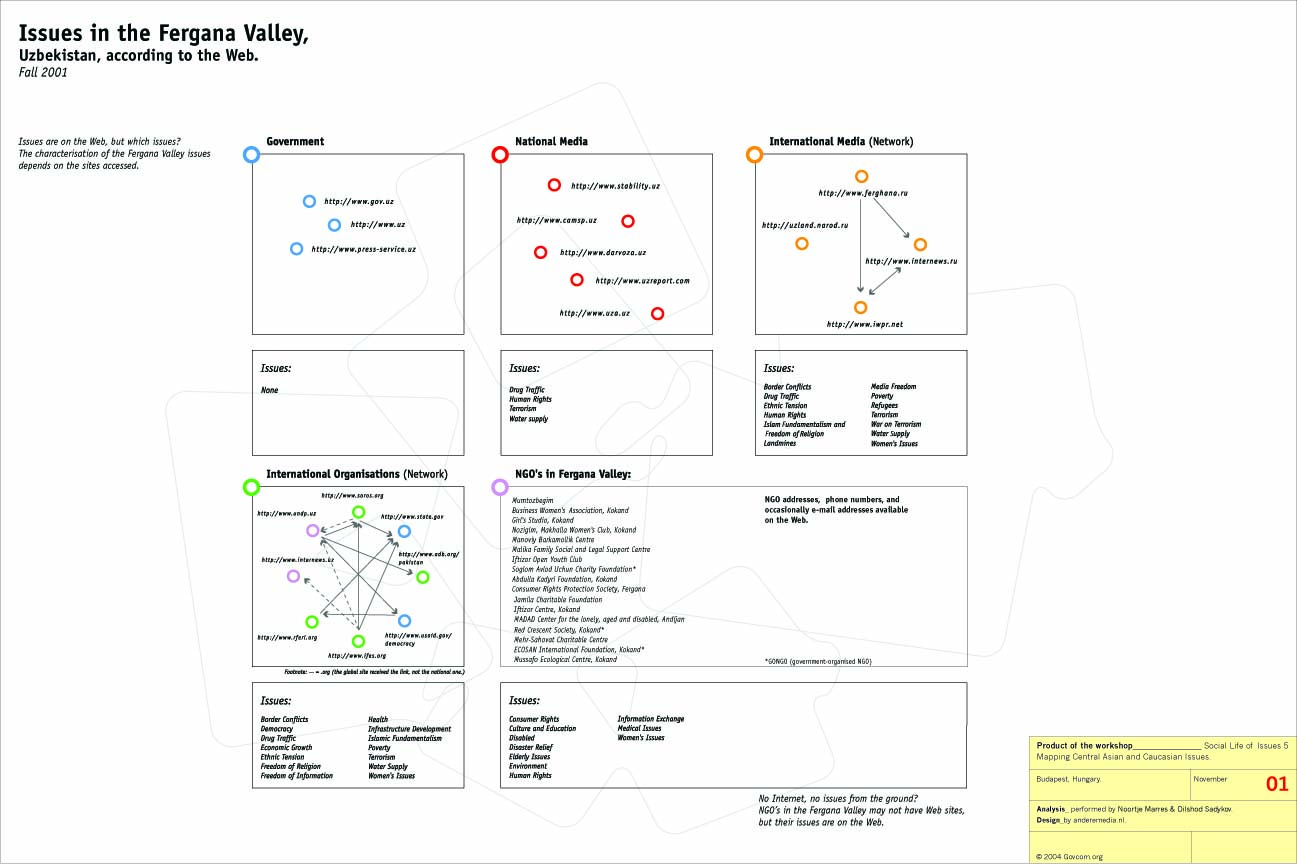Ferghana Valley
What are the issues on the ground in the Ferghana Valley (Summer 2001)
(from: N. Marres and R. Rogers (2008) Subsuming the Ground: How local realities of the Ferghana Valley, the Narmada Dams, and the BTC pipeline are put to use on the Web. Economy and Society, 37(2): 251-281.)
The methods of mapping issue networks on the Web can also be used to evaluate particular relations between ‘the global’ and ‘the local’ in processes of issue formation. To this end, we conducted a small Web analysis of the issues of the Ferghana Valley, in Central Asia. We asked: can the global Web tell us what are the local issues of the Ferghana Valley?

Issues in the Fergana Valley, Uzbekistan, according to the Web, Fall 2001. Source: issuecrawler.net, Govcom.org Foundation, Amsterdam.
During a workshop on ‘Mapping Central Asian Issues’, which took place in Budapest in the summer of 2001, we explored the extent to which the global medium of the Web could disclose for us a distant locality in Central Asia, the Ferghana Valley, a region on the borders between Uzbekistan, Kyrgyzstan and Tajikistan, with low Internet access. In performing this exercise, we are challenged by a host of constraints, including but not limited to our language skills (only English, Dutch, German and French are available to us) as well as content- and infrastructure-related biases of the Web.
However, in collaboration with two workshop participants who were familiar with the region, Dilshod Sadykov and David Stubbs, we were able to use Web analysis to disclose local issues in the Ferghana Valley. As Dilshod Sadykov not only spoke Uzbek and Russian, but also knows his way around the Uzbek news media andWeb spaces, and David Stubbs knew the Central Asian NGO scene, we were able to demarcate a series of more or less ‘localized’ clusters and networks on the Web that dealt with the Ferghana Valley: an Uzbek governmental cluster, an Uzbek media cluster, a international media network, a transnational NGO network and, finally, a set of Uzbek NGOs that are active in the Fergana Valley.
From these clusters and networks, we subsequently derived the issues of the Ferghana Valley disclosed by each cluster. Because David Stubbs knew how to distinguish between Uzbek NGOs that are organized by the government and those that are more independent, we felt we reached ‘the ground’, in a sense, when we made the list of issues on which the latter are working (see Figures 1a and 1b).
Our Web study of the Ferghana Valley problematized for us the tendency in some studies of ICTs and NGOs to grant _local_ articulations of issues a normative and analytical priority over _global_ ones. To begin with a basic point, Web study of a faraway region in Central Asia makes it particularly clear how much is required to access a ‘locality’ in terms of resources and skills, from our particular vantage point as researchers based in urban centres in Western Europe. As such, the Web could be understood as making more broadly relevant an important insight in anthropological theory, that access to the ‘local’ depends on particular large-scale infrastructures (Gupta & Ferguson, 1997).
Furthermore, our exercise made it clear that it cannot be maintained unconditionally that the closer actors are to the ground, the more they can tell us about what is going on there. In the case of the Ferghana Valley, it was in some sense the other way around. With respect to formalized information about this region, the transnational NGOs were much more informative than the Uzbek government bodies and Uzbek NGOs. While our medium of approach, i.e. the fact that we approached the ground via the Web, instead of actually going there, certainly has to do with this, it also has to do with the particular constraints that different actors face when it comes to the publicizing of accounts of local realities in a worldwide medium like the Web, in terms of infrastructural and moral and political conditions.
